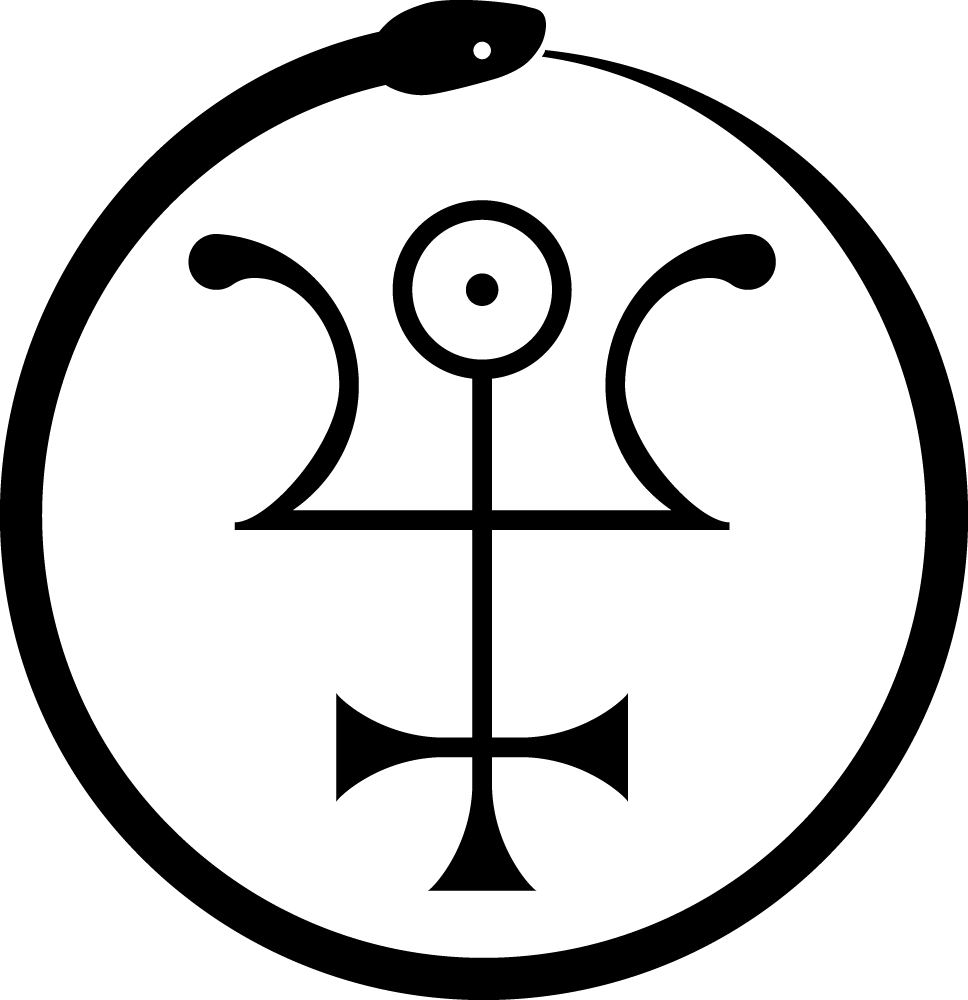Liber XXV: The Star Ruby
Composed by Aleister Crowley for the Order A∴A∴
Unofficial notes and comments in brackets by Sabazius.
[I. ]
Facing East, in the centre, draw deep deep deep thy breath closing thy mouth with thy right forefinger prest against thy lower lip. Then dashing down the hand with a great sweep back and out, expelling forcibly thy breath, cry APO PANTOS KAKODAIMONOS [“Away, every evil spirit”].
[II. The Cross Qabalistic]
With the same forefinger touch thy forehead, and say SOI [“Thine”], thy member, and say Ô PhALLE [“O Phallus”], thy right shoulder, and say ISChUROS [“the mighty”], thy left shoulder, and say EUChARISTOS [“the beneficient”]; then clasp thine hands, locking the fingers, and cry IAÔ.
[III.]
Advance to the East. Imagine strongly a Pentagram, aright, in thy forehead. Drawing the hands to the eyes, fling it forth, making the sign of Horus and roar ThÊRION. Retire thine hand in the sign of Hoor-paar-Kraat.
Go round to the North and repeat; but say NUIT.
Go round to the West and repeat; but whisper BABALON.
Go round to the South and repeat; but bellow HADIT.
[IV. ]
Completing the circle widdershins, retire to the centre and raise thy voice in the Paian, with these words IÔ PAN, with the signs of N.O.X.
[V. ]
Extend the arms in the form of a Tau and say low but clear:
PRO MOU YUNGES [“Before me the Iynges,”]
OPISÔ MOU TELETARChAI [“Behind me the Teletarches,”]
EPI DEXIA SUNOChEIS [“on my right hand the Synoches,”]
EPARISTERA DAIMONES [“on my left hand the Daemones,”]
PhLEGEI GAR PERI MOU hO ASTÊR TÔN PENTE [“for about me flames the Star of Five,”]
KAI EN TÊI STÊLÊI hO ASTÊR TÔN hEX hESTÊKE. [“and in the Pillar stands the Star of Six.”]
[VI. ]
Repeat the Cross Qabalistic, as above [II], and end as thou didst begin [i.e., as in I].
Notes:
This is one of the official rituals of the A∴A∴ It was first published by Frater Perdurabo in 1913 e.v., in a somewhat different form, as Chapter XXV of Liber CCCXXXIII, The Book of Lies. It was published in revised form in 1929 e.v. in Appendix VI of Book 4, Part III: Magick in Theory and Practice. In his commentary to Chapter XXV of The Book of Lies, Crowley described this ritual as “a new and more elaborate version of the Banishing Ritual of the Pentagram.” My notes and comments are unofficial and informal. They represent my personal opinions based on my own studies.
The term “Phallus” may be interpreted, in Crowley’s words, as the “immortal principle” of either a man or a woman. It is the Principle of Life, continuously renewing itself through the cycle of death and generation.
IAO is the Gnostic form of the Tetragrammaton, IHVH. The individual letters Iota, Alpha, and Omega represent the Essence, the Beginning, and the End, respectively. Thus, IAO is the equivalent of the Hebrew phrase, le-Olahm, Amen in the Lesser Ritual of the Pentagram. It is also a Divine Name of the sphere of Tiphareth, corresponding to the heart.
Therion, Nuit, Babalon and Hadit are divine names from the Holy Books of Thelema. The Signs of Horus and of Hoor-paar-Kraat (Harpocrates) are shown in Figure 33A,B on page 606 of Magick: Liber ABA, Book Four, Parts I-IV by Aleister Crowley, Samuel Weiser 1994.
In classical terminology, a “paian” was a song of praise, especially to Apollo. In this case, the paian is to the Great God Pan, where PAN may be translated as “All.” Also, the five letters I.O.P.A.N. correspond to the five N.O.X. signs, which are shown in Figure 33L-P on page 607 of Magick.
The Iynges (singular “Iynx”), Synoches, Teletarches and Daemones are divine principles from the Second Order of the emanationist hierarchy of late Neoplatonism, based on the Chaldean Oracles of Zoroaster. Their position in the Neoplatonist hierarchy is intermediate between the “intelligible” world, or world of ideation, and the “sensible” world, or world of perception. Their functions are, respectively, as “initiators,” “maintainers,” “perfectors,” and “executors” of the Divine Creative Impulse which originates in the intelligible world and ultimately manifests in the sensible world. Further information on them may be found in the published editions of the Chaldean Oracles edited by W. Wynn Westcott and G.R.S. Mead, and in the works of Proclus, Damascius, Michael Psellus, George Gemistos Plethon, and other late Neoplatonist philosophers.
